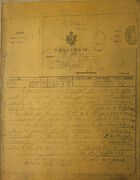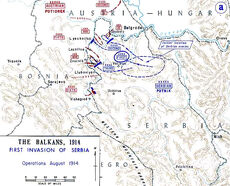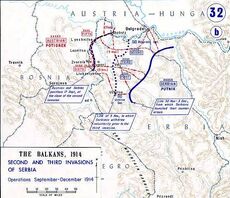The Serbian campaign was the series of campaigns launched against Serbia at the beginning of the World War. The first campaign began after Austria Hungary declared war on Serbia on 28 July 1914, the campaign to "punish" Serbia, under the command of Austrian Oskar Potiorek, ended after three unsuccessful Austro-Hungarian invasion attempts were repelled by the Serbians and their Montenegrin allies. Serbia's defeat of the Austro-Hungarian invasion of 1914 ranks as one of the great upsets of modern military history.
The second campaign was launched, under German command, almost a year later, on 6 October 1915, when Bulgarian, Austrian, and German forces, led by Field Marshall August von Mackensen, invaded Serbia from three sides, per-empting the Allied advance from Salonica to help Serbia. This resulted in the Great Retreat through Montenegro and Albania, the evacuation to Greece and the establishment of the Macedonian front. The defeat of Serbia gave the Central Powers temporary mastery over the Balkans, opening up a land route from Berlin to Istanbul, allowing the Germans to re-supply the Ottoman Empire for the rest of the war. Mackensen declared an end to the campaign on 24 November 1915. Serbia was then occupied and divided between the Austro-Hungarian Empire and Bulgaria.
The Serbian Army declined severely from about 420,000 at its peak to about 100,000 at the time of the Western armistice. The estimates of casualties are various: Serb sources claim that the Kingdom of Serbia lost more than 1,200,000 inhabitants during the war (both army and civilian losses), which represented more than 29% of its overall population and 60% of its male population, while western historians put the number either at 45,000 military deaths and 650,000 civilian deaths or 127,355 military deaths and 82,000 civilian deaths. According to estimates prepared by the Yugoslav government in 1924, Serbia lost 265,164 soldiers, or 25% of all mobilized people. By comparison, France lost 16.8%, Germany 15.4%, Russia 11.5%, and Italy 10.3%.
Background[]
Austria-Hungary precipitated the Bosnian crisis of 1908–09 by annexing the former Ottoman territory of Bosnia and Herzegovina, which it had occupied since 1878. This angered the Kingdom of Serbia and its patron, the Pan-Slavic and Orthodox Russian Empire. Russian political maneuvering in the region destabilized peace accords that were already unraveling in what was known as "the powder keg of Europe".
Gavrilo Princip, a member of the Young Bosnia, assassinated Archduke Franz Ferdinand, the heir to the Austro-Hungarian throne
In 1912 and 1913, the First Balkan War was fought between the Balkan League of Greece, Bulgaria, Serbia, and Montenegro and the fracturing Ottoman Empire. The resulting Treaty of London further shrank the Ottoman Empire by creating an independent Principality of Albania and enlarging the territorial holdings of Bulgaria, Serbia, Montenegro, and Greece. When Bulgaria attacked both Serbia and Greece on 16 June 1913, it lost most of its Macedonian region to those countries, and additionally the Southern Dobruja region to Romania and Adrianople (the present-day city of Edirne) to Turkey in the 33-day Second Balkan War, which further destabilized the region.
On 28 June 1914, Gavrilo Princip, a Bosnian Serb student and member of a multi-ethnic organization of national revolutionaries called Young Bosnia, assassinated Archduke Franz Ferdinand of Austria, the heir to the Austro-Hungarian throne, in Sarajevo, Bosnia. The political objective of the assassination was the independence of the southern Austro-Hungarian provinces mainly populated by Slavs from the Austro-Hungarian Empire, though it also inadvertently triggered a chain of events that embroiled Russia and the major European powers. This began a period of diplomatic maneuvering among Austria-Hungary, Germany, Russia, France, and Britain called the July Crisis. Austria-Hungary delivered the July Ultimatum to Serbia, a series of ten demands intentionally made unacceptable in order to provoke a war with Serbia. When Serbia agreed to only eight of the ten demands, Austria-Hungary declared war on 28 July 1914.

The Austro-Hungarian government's declaration of war in a telegram sent to the government of Serbia on 28 July 1914, signed by Imperial Foreign Minister Count Leopold Berchtold.
The dispute between Austria-Hungary and Serbia escalated into what is now known as the World War, and drew in Russia, Germany, France, and the United Kingdom. Within a week, Austria-Hungary had to face a war with Russia, Serbia's patron, which had the largest army in the world at the time. The result was that Serbia became a subsidiary front in the massive fight that started to unfold along Austria-Hungary's border with Russia. Serbia had an experienced army, but it was also exhausted from the conflicts of the Balkan Wars and poorly equipped, which led the Austro-Hungarians to believe that it would fall in less than a month. Serbia's strategy was to hold on as long as it could and hope the Russians could defeat the main Austro-Hungarian Army, with or without the help of other allies. Serbia constantly had to worry about its hostile neighbor to the east, Bulgaria, with which it had fought several wars, most recently in the Second Balkan War of 1913.
1914[]
The Serbian campaign started on 28 July 1914, when Austria-Hungary declared war on Serbia and her artillery shelled Belgrade the following day. On August 12 the Austro-Hungarian armies crossed the border, the Drina River (see map).
Initially, three out of six Austro-Hungarian armies were mobilized at the Serbian frontier, but due to Russian intervention, the 2nd Army was redirected east to the Galician theater. However, since the railroad lines leading to Galicia were busy with transport of other troops, the 2nd Army could only start its departure northward on 18 August. In order to make use of the temporary presence of the 2nd Army, AOK allowed parts of it to be used in the Serbian campaign until that date. Eventually, AOK directed significant parts of the 2nd Army (around four divisions) to assist General Potiorek's main force and postponed their transportation to Russia until the last week of August. Defeats suffered in the first invasion of Serbia eventually forced AOK to transfer two divisions from 2nd Army to Potiorek's army permanently.
The V and VI Austro-Hungarian Armies had about 270,000 men who were much better equipped than the Serbs. Overall, Austro-Hungarian command was in the hands of General Potiorek. The Austro-Hungarian Empire had the third largest population in Europe in 1914, behind Russia and Germany (almost twelve times the population of the Kingdom of Serbia), giving it an enormous manpower advantage.
Battle of Cer[]

First Attack on Serbia, August 1914
Potiorek rushed the attack against Serbia from northern Bosnia with his Fifth Army, supported by elements of the Second Army from Syrmia. The Second Army was due to be transported to Galicia to face the Russians at the end of August, but he made use of it until then. The Sixth was positioning itself in southern Bosnia and was not yet able to commence offensive operations. Potiorek's desire was to win a victory before Emperor Franz Joseph's birthday and to knock Serbia out as soon as possible. Thus he made two grave strategic errors by attacking with only just over half of his strength and attacking hilly western Serbia instead of the open plains of the north. This move surprised Marshal Putnik, who expected attack from the north and initially believed that it was a feint. Once it became clear that it was the main thrust, the strong Second Army under the command of General Stepa Stepanović was sent to join the small Third Army under Pavle Jurišić Šturm already facing the Austro-Hungarians and expel the invaders. After a fierce four-day battle, the Austro-Hungarians were forced to retreat, marking the first Entente victory of the war over the Central Powers led by Germany and Austria-Hungary. Casualties numbered 23,000 for the Austro-Hungarians (of whom 4,500 were captured) and 16,500 for the Serbs.
Town of Šabac which was on river Sava norther border of Serbia with Austria-Hungary destroyed in bombardment and street fighting in 1914
Battle of Drina[]
Serbian soldiers during the Battle of Drina
The remain of Serbian in battle of Mačkov Kamen
Under pressure from its allies, Serbia conducted a limited offensive across the Sava river into the Austro-Hungarian region of Syrmia with its Serbian First Army. The main operational goal was to delay the transport of the Austro-Hungarian Second Army to the Russian front. The objective was shown to be futile as forces of the Second Army were already in transports. Meanwhile, the Timok division I of the Serbian Second Army suffered a heavy defeat in a diversionary crossing, suffering around 6,000 casualties while inflicting only 2,000.
With most of his forces in Bosnia, Potiorek decided that the best way to stop the Serbian offensive was to launch another invasion into Serbia to force the Serbs to recall their troops to defend their much smaller homeland.
"The Serbians, seasoned, war-hardened men, inspired by the fiercest patriotism, the result of generations of torment and struggle, awaited undaunted whatever fate might bestow."
7 September brought a renewed Austro-Hungarian attack from the west, across the river Drina, this time with both the Fifth Army in Mačva and the Sixth further south. The initial attack by the Fifth Army was repelled by the Serbian Second Army, with 4,000 Austro-Hungarian casualties, but the stronger Sixth Army managed to surprise the Serbian Third Army and gain a foothold. After some units from the Serbian Second Army were sent to bolster the Third, the Austro-Hungarian Fifth Army also managed to establish a bridgehead with a renewed attack. At that time, Marshal Putnik withdrew the First Army from Syrmia (against much popular opposition) and used it to deliver a fierce counterattack against the Sixth Army that initially went well, but finally bogged down in a bloody four-day fight for a peak of the Jagodnja mountain called Mačkov Kamen, in which both sides suffered horrendous losses in successive frontal attacks and counterattacks. Two Serbian divisions lost around 11,000 men, while Austro-Hungarian losses were probably comparable.
Marshal Putnik ordered a retreat into the surrounding hills and the front settled into a month and a half of trench warfare, which was highly unfavorable to the Serbs, who had little in the way of an industrial base and were deficient in heavy artillery, ammunition stocks, shell production and footwear, since the vast majority of infantry wore the traditional (though state-issued) opanaks, while the Austro-Hungarians had waterproof leather boots. Most of their war material was supplied by the Entente, who were short of such materials themselves. In such a situation, Serbian artillery quickly became almost silent, while the Austro-Hungarians steadily increased their fire. Serbian casualties reached 100 soldiers a day from all causes in some divisions.
During the first weeks of trench warfare, the Serbian Užice Army (first strengthened division) and the Montenegrin Sanjak Army (roughly a division) conducted an abortive offensive into Bosnia. In addition, both sides conducted a few local attacks, most of which were soundly defeated. In one such attack, the Serbian Army used mine warfare for the first time: the Combined Division dug tunnels beneath the Austro-Hungarian trenches (that were only 20–30 meters away from the Serbian ones on this sector), planted mines and set them off just before an infantry charge.
Battle of Kolubara[]

Later Operations in Serbia, 1914
Serbian artillery in trenches in 1914
Having thus weakened the Serbian army, the Austro-Hungarian Army launched another massive attack on 5 November. The Serbs withdrew step by step, offering strong resistance at the Kolubara River, but to no avail, due to the lack of artillery ammunition. It was at that time that General Živojin Mišić was made commander of the battered First Army, replacing the wounded Petar Bojović. He insisted on a deep withdrawal in order to give the troops some much-needed rest and to shorten the front. Marshal Putnik finally relented, but the consequence was the abandonment of the capital city of Belgrade. After suffering heavy losses, the Austro-Hungarian Army entered the city on 2 December. This action led Potiorek to move the whole Fifth Army into the Belgrade area and use it to crush the Serbian right flank. This, however, left the Sixth alone for a few days to face the whole Serbian army.
At this point, artillery ammunition finally arrived from France and Greece. In addition, some replacements were sent to the units and Marshal Putnik correctly sensed that the Austro-Hungarian forces were dangerously overstretched and weakened in the previous offensives, so he ordered a full-scale counterattack with the entire Serbian Army on 3 December against the Sixth Army. The Fifth hurried its flanking maneuver, but it was already too late – with the Sixth Army broken, the Second and Third Serbian Armies overwhelmed the Fifth. Finally, Potiorek lost his nerve and ordered yet another retreat back across the rivers into Austria-Hungary's territory. The Serbian Army recaptured Belgrade on 15 December.
Živojin Mišić
The first phase of the war against Serbia had ended with no change in the border, but casualties were enormous compared to earlier wars, albeit comparable to other campaigns of the World War. The Serbian army suffered 170,000 men killed, wounded, captured or missing. Austro-Hungarian losses were approaching 215,000 men killed, wounded or missing. Austro-Hungarian General Potiorek was removed from command and replaced by Archduke Eugen of Austria. On the Serbian side, a deadly typhus epidemic killed hundreds of thousands of Serb civilians during the winter.
After the Battle of Kolubara, the Serbian Parliament adopted the Niš Declaration (7 December 1914) on the war goals of Serbia: "Convinced that the entire Serbian nation is determined to persevere in the holy struggle for the defense of their homesteads and their freedom, the government of the Kingdom (of Serbia) considers that, in these fateful times, its main and only task is to ensure the successful completion of this great warfare which, at the moment when it started, also became a struggle for the liberation and unification of all our unliberated Serbian, Croatian and Slovenian brothers. The great success which is to crown this warfare will make up for the extremely bloody sacrifices which this generation of Serbs is making". This amounted to announcing Serbia's intention to annex extensive amounts of Austria-Hungary's Balkan provinces.